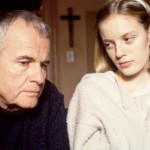Dir. by Atom Egoyan
Images: Beautiful compositions in 2.35:1. Notable images: close-up of infant Chloe’s face beside open knife blade; Nicole’s face with rotating Ferris wheel over her shoulder; Mitchell, wife, and child asleep together on mattress. Egoyan constantly returns to wide-angle shots of the sky and the Canadian landscape as a means of representing man’s insignificance in relation to nature. The images of snow-covered, tree-lined mountains, gray skies, and frozen lakes contrast beautifully with the warm interiors of the small town and the close-ups of its inhabitants. The flesh tones reflect their environment: soft and natural when inside, slightly blue when out.
• • •
There’s a scene in The Sweet Hereafter in which Mitchell Stephens — a big city ambulance chaser played to perfection by Ian Holm — sits in a cramped airplane seat, telling the passenger beside him a story from when his daughter, Chloe, was a child. The shot is framed with Holm’s face in a tight close-up, his companion to our left, her eyes fixed intently on his. During the entire, nearly six-minute monologue (there is only one brief interruption — a cutaway to a flashback), neither actor turns his or her head more than an inch. Holm’s eyes never look away from the back of the seat in front of him. And yet, it’s one of the most riveting moments from any film I’ve seen.
And it exemplifies why Atom Egoyan’s The Sweet Hereafter might be the best film of the 90’s. Stephens’ story is a step into an idyllic past. “It was a wonderful time in our lives,” he says. “We still thought we had a future together, the three of us.” Like Egoyan’s film, the lawyer’s story is an attempt to create a narrative from tragedy as a means of controlling and (hopefully) escaping its grief. The result is a film that is captivating despite — or perhaps because of — its preoccupation with sadness. Its very beauty is catharsis.
Mitchell Stephens arrives in Sam Dent shortly after a school bus accident takes the lives of many of the small town’s children. Stephens’ goal is to unite several of the families in a class action lawsuit against the “deep pockets” who are to blame. For the parents, placing blame becomes a release, a means of turning their attention momentarily from loss and grief and reuniting the community. Many of Sam Dent’s residents are recognizable from Egoyan’s earlier films. Maury Chaykin and Alberta Watson play Wendell and Risa Walker, the proprietors of the town’s only motel and plaintiffs in the law suit. Bruce Greenwood (the lead in Exotica) is Billy Ansel, a widower who loses both of his children in the accident, but who refuses Stephens’ offer. Arsinee Khanjian (Egoyan’s wife) and Earl Pastko are Wanda and Hartley Otto, another couple grieving for their only child. And Gabrielle Rose plays Delores Driscoll, the bus driver who loses so many of “her children” in the accident.
The acting is dynamic throughout. Of particular note is the performance of Sarah Polley (Exotica), who plays Nicole Burnell, a survivor paralyzed in the accident. The film demands that she strike a balance between the innocence of childhood and the pain of tragic experience (an important side plot reveals that the bus accident is not the only traumatic experience Nicole is forced to overcome). Polley’s approach is wonderfully subtle and understated. She has said of her performance: “The only way I feel I’m not faking it is to do nothing at all. I really don’t consider myself an actor, or a performer, but maybe as someone able to fill whatever void there is among actors who do too much.” As in Holm’s monologue, Polley is filmed almost entirely in close-ups and medium shots, directing our attention to her remarkably expressive eyes.
